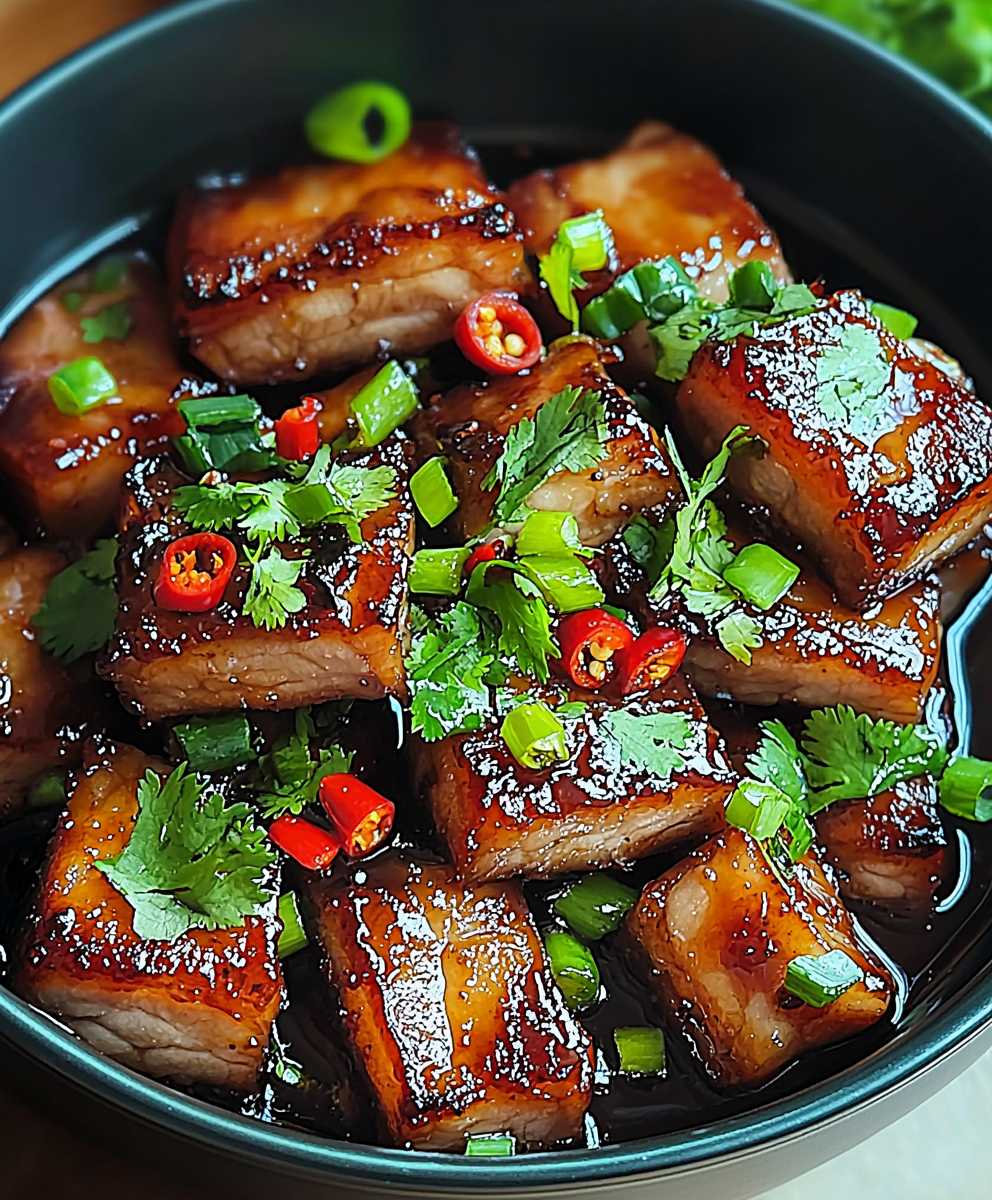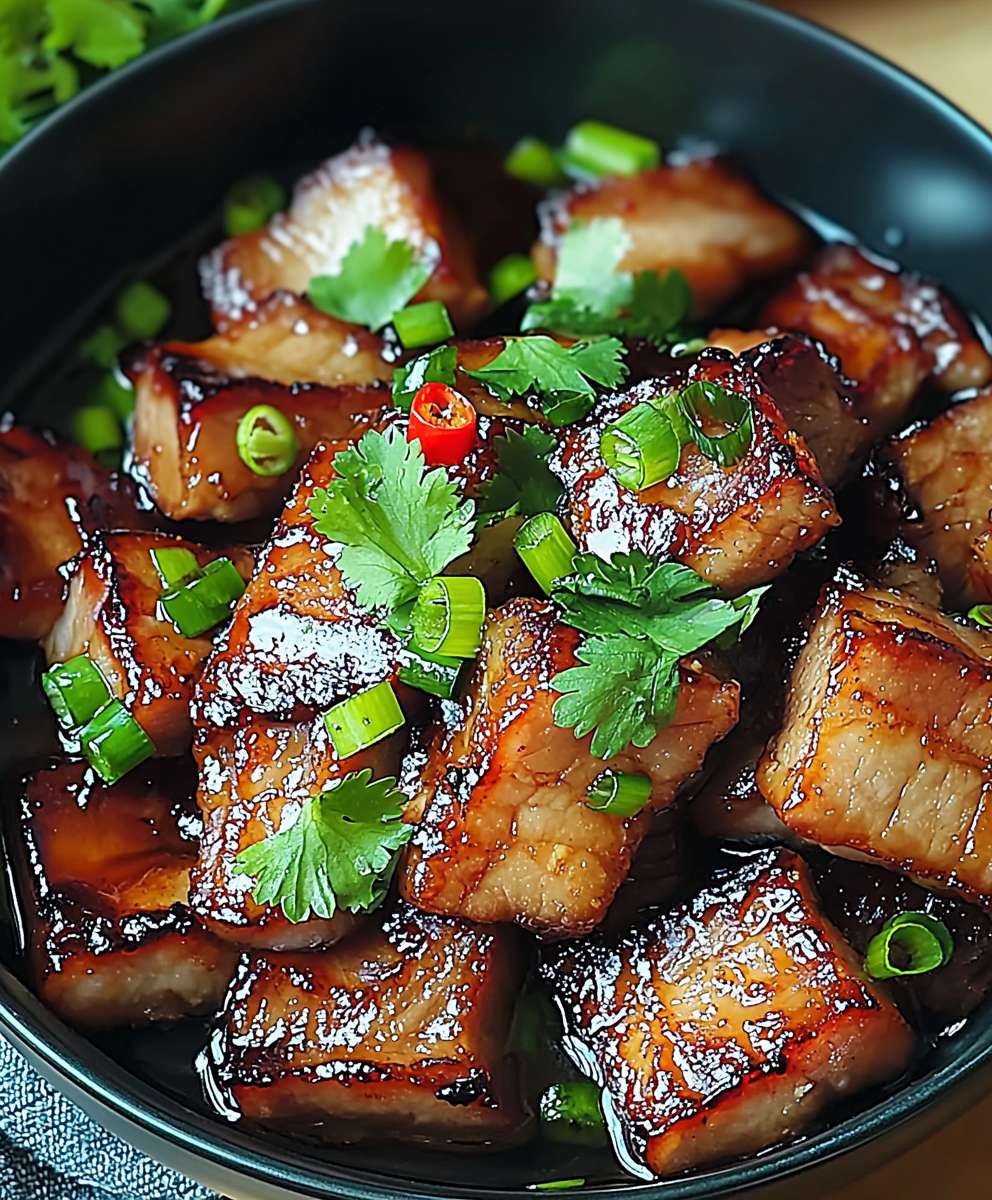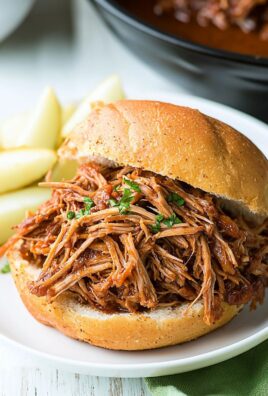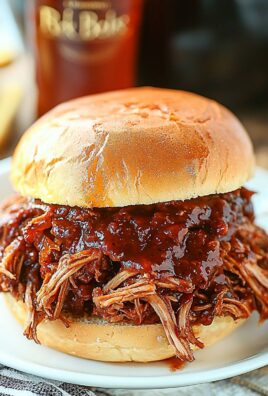Caramelized Vietnamese Pork, or Thit Kho Tau as it’s known in Vietnam, is more than just a recipe; it’s a culinary hug, a taste of home, and a dish steeped in tradition. Imagine tender, melt-in-your-mouth pork belly, braised to perfection in a sweet and savory caramel sauce, its richness balanced by the subtle tang of fish sauce and the warmth of aromatics. Are you already drooling? I know I am just thinking about it!
This iconic dish is a staple in Vietnamese households, particularly during T?t, the Vietnamese Lunar New Year. It symbolizes prosperity and togetherness, often shared amongst family and friends as a gesture of good fortune for the year ahead. The slow braising process, often taking hours, reflects the care and dedication poured into creating a truly special meal.
But you don’t have to wait for a special occasion to enjoy this incredible dish! People adore Caramelized Vietnamese Pork for its incredible depth of flavor. The combination of sweet, savory, and umami creates a symphony on the palate. The tender, almost gelatinous texture of the pork is simply irresistible, and the rich sauce is perfect for spooning over a bed of fluffy rice. Plus, it’s surprisingly easy to make at home, requiring just a handful of ingredients and a little patience. So, let’s embark on this culinary journey together and create a dish that will transport you straight to the heart of Vietnam!
Ingredients:
- 2 pounds pork shoulder, cut into 1-inch cubes
- 2 tablespoons vegetable oil
- 1 large onion, thinly sliced
- 4 cloves garlic, minced
- 1-inch piece of ginger, peeled and minced
- 1/2 cup granulated sugar
- 1/4 cup fish sauce
- 2 tablespoons soy sauce
- 1 tablespoon dark soy sauce (for color, optional)
- 1 teaspoon black pepper
- 1/2 teaspoon red pepper flakes (optional, for heat)
- 2 cups water or chicken broth
- 2 green onions, thinly sliced, for garnish
- Cooked rice, for serving
- Optional garnishes: cilantro, pickled vegetables
Preparing the Pork and Aromatics:
- Prepare the Pork: Pat the pork shoulder cubes dry with paper towels. This helps them brown better during the searing process. Don’t skip this step!
- Sear the Pork: Heat the vegetable oil in a large, heavy-bottomed pot or Dutch oven over medium-high heat. You want the pot to be nice and hot before adding the pork. Add the pork in batches, being careful not to overcrowd the pot. Overcrowding will lower the temperature of the pot and cause the pork to steam instead of sear. Sear each batch for 2-3 minutes per side, until nicely browned. Remove the seared pork from the pot and set aside.
- Sauté the Aromatics: Reduce the heat to medium. Add the sliced onion to the pot and cook, stirring occasionally, until softened and translucent, about 5-7 minutes. Don’t rush this step; allowing the onions to soften properly will build a good flavor base.
- Add Garlic and Ginger: Add the minced garlic and ginger to the pot and cook for another minute, until fragrant. Be careful not to burn the garlic, as it can become bitter.
Making the Caramel:
- Caramelize the Sugar: This is a crucial step for achieving that signature Vietnamese caramelized flavor. Push the onions, garlic, and ginger to the side of the pot. Add the granulated sugar to the center of the pot. Let the sugar melt undisturbed over medium heat. It will first clump together, then gradually melt into a clear liquid.
- Watch Carefully: As the sugar melts, it will start to turn golden brown. Watch it very carefully, as it can burn quickly. You want a deep amber color, but not burnt black. Burnt sugar will make the dish bitter.
- Deglaze with Fish Sauce: Once the sugar has reached a deep amber color, carefully pour in the fish sauce. Be prepared for it to sputter and steam! Stir quickly to combine the fish sauce with the caramelized sugar. The mixture will likely seize up at first, but keep stirring and it will eventually smooth out.
- Add Soy Sauce and Dark Soy Sauce: Add the soy sauce and dark soy sauce (if using) to the pot. Stir to combine. The dark soy sauce adds a richer color and deeper flavor, but it’s optional if you don’t have it on hand.
Braising the Pork:
- Return the Pork: Return the seared pork to the pot. Stir to coat the pork with the caramel sauce. Make sure all the pork pieces are well coated.
- Add Seasoning: Add the black pepper and red pepper flakes (if using) to the pot. Stir to combine.
- Add Liquid: Pour in the water or chicken broth. The liquid should almost cover the pork. If needed, add a little more liquid to ensure the pork is mostly submerged.
- Bring to a Simmer: Bring the mixture to a simmer over medium heat. Once simmering, reduce the heat to low, cover the pot, and let it simmer gently for at least 2-3 hours, or until the pork is very tender and easily shreds with a fork. The longer it simmers, the more flavorful it will become.
- Check Periodically: Check the pot periodically during the simmering process. If the liquid is reducing too quickly, add a little more water or broth.
Reducing the Sauce:
- Remove the Lid: Once the pork is tender, remove the lid from the pot. Increase the heat to medium and let the sauce simmer and reduce until it thickens to a glaze-like consistency. This will take about 20-30 minutes, depending on how much liquid is left in the pot.
- Stir Frequently: Stir the pork frequently during the sauce reduction process to prevent it from sticking to the bottom of the pot and burning.
- Adjust Seasoning: Taste the sauce and adjust the seasoning as needed. You may want to add a little more fish sauce for saltiness, sugar for sweetness, or pepper for spice.
Serving:
- Serve Hot: Serve the caramelized Vietnamese pork hot over cooked rice.
- Garnish: Garnish with thinly sliced green onions and optional garnishes such as cilantro and pickled vegetables. The fresh herbs and pickled vegetables add a nice contrast to the rich, savory pork.
- Enjoy! Enjoy your delicious and authentic Caramelized Vietnamese Pork!

Conclusion:
So, there you have it! This recipe for Caramelized Vietnamese Pork is truly a must-try, and I’m not just saying that. The combination of savory, sweet, and slightly spicy flavors creates a symphony in your mouth that will leave you craving more. It’s a dish that’s both comforting and exciting, familiar yet exotic. The tender, melt-in-your-mouth pork, coated in that luscious, sticky caramel sauce, is simply irresistible.
But beyond the incredible taste, what makes this recipe so special is its versatility. It’s perfect for a weeknight dinner when you want something quick and satisfying, but it’s also impressive enough to serve to guests. Imagine presenting a platter of glistening, caramelized pork at your next dinner party you’re guaranteed to wow everyone!
And the best part? It’s surprisingly easy to make. While the name might sound intimidating, the recipe itself is straightforward and doesn’t require any fancy techniques or hard-to-find ingredients. With just a few simple steps, you can create a restaurant-quality dish in the comfort of your own kitchen.
Now, let’s talk about serving suggestions and variations. While this Caramelized Vietnamese Pork is delicious on its own, it’s even better when paired with the right accompaniments. I personally love serving it over a bed of fluffy jasmine rice, which perfectly soaks up all that delicious caramel sauce. A side of steamed bok choy or stir-fried vegetables adds a touch of freshness and balances out the richness of the pork.
For a more complete meal, consider adding some pickled carrots and daikon radish (do chua) for a tangy and crunchy contrast. A sprinkle of chopped peanuts and fresh cilantro adds a final touch of flavor and texture.
If you’re feeling adventurous, you can also try using this recipe as a filling for banh mi sandwiches. Imagine biting into a crusty baguette filled with tender caramelized pork, pickled vegetables, cilantro, and a smear of mayonnaise pure heaven!
Another variation you might enjoy is adding a touch of heat to the caramel sauce. A pinch of red pepper flakes or a drizzle of sriracha will give the dish a spicy kick that’s sure to wake up your taste buds. You could also experiment with different cuts of pork. While pork shoulder is my go-to choice for its tenderness and flavor, pork belly or even pork tenderloin would also work well. Just be sure to adjust the cooking time accordingly.
Don’t be afraid to get creative and experiment with different flavors and ingredients. The beauty of this recipe is that it’s a blank canvas that you can customize to your own liking.
I truly believe that this Caramelized Vietnamese Pork recipe is a winner. It’s delicious, easy to make, and incredibly versatile. It’s a dish that you’ll want to make again and again, and one that you’ll be proud to share with your friends and family.
So, what are you waiting for? Grab your ingredients, put on your apron, and get cooking! I’m confident that you’ll love this recipe as much as I do.
And once you’ve tried it, I’d love to hear about your experience. Share your photos and comments on social media using [Your Hashtag Here]. Let me know what variations you tried and what you thought of the dish. I’m always looking for new ideas and inspiration, and I can’t wait to see what you create! Happy cooking!
Caramelized Vietnamese Pork: A Delicious and Easy Recipe
Tender pork shoulder braised in a rich, caramelized sauce with fish sauce, soy sauce, and aromatics. A classic Vietnamese comfort food, perfect served over rice.
Ingredients
- 2 pounds pork shoulder, cut into 1-inch cubes
- 2 tablespoons vegetable oil
- 1 large onion, thinly sliced
- 4 cloves garlic, minced
- 1-inch piece of ginger, peeled and minced
- 1/2 cup granulated sugar
- 1/4 cup fish sauce
- 2 tablespoons soy sauce
- 1 tablespoon dark soy sauce (for color, optional)
- 1 teaspoon black pepper
- 1/2 teaspoon red pepper flakes (optional, for heat)
- 2 cups water or chicken broth
- 2 green onions, thinly sliced, for garnish
- Cooked rice, for serving
- Optional garnishes: cilantro, pickled vegetables
Instructions
- Pat the pork shoulder cubes dry with paper towels.
- Heat the vegetable oil in a large, heavy-bottomed pot or Dutch oven over medium-high heat. Add the pork in batches, being careful not to overcrowd the pot. Sear each batch for 2-3 minutes per side, until nicely browned. Remove the seared pork from the pot and set aside.
- Reduce the heat to medium. Add the sliced onion to the pot and cook, stirring occasionally, until softened and translucent, about 5-7 minutes.
- Add the minced garlic and ginger to the pot and cook for another minute, until fragrant.
- Push the onions, garlic, and ginger to the side of the pot. Add the granulated sugar to the center of the pot. Let the sugar melt undisturbed over medium heat until it turns a deep amber color. Watch carefully to avoid burning.
- Once the sugar has reached a deep amber color, carefully pour in the fish sauce. Stir quickly to combine the fish sauce with the caramelized sugar.
- Add the soy sauce and dark soy sauce (if using) to the pot. Stir to combine.
- Return the seared pork to the pot. Stir to coat the pork with the caramel sauce.
- Add the black pepper and red pepper flakes (if using) to the pot. Stir to combine.
- Pour in the water or chicken broth. The liquid should almost cover the pork.
- Bring the mixture to a simmer over medium heat. Once simmering, reduce the heat to low, cover the pot, and let it simmer gently for at least 2-3 hours, or until the pork is very tender and easily shreds with a fork.
- Check the pot periodically during the simmering process. If the liquid is reducing too quickly, add a little more water or broth.
- Once the pork is tender, remove the lid from the pot. Increase the heat to medium and let the sauce simmer and reduce until it thickens to a glaze-like consistency, about 20-30 minutes. Stir frequently to prevent sticking.
- Taste the sauce and adjust the seasoning as needed.
- Serve the caramelized Vietnamese pork hot over cooked rice.
- Garnish with thinly sliced green onions and optional garnishes such as cilantro and pickled vegetables.
Notes
- Patting the pork dry before searing is crucial for browning.
- Don’t overcrowd the pot when searing the pork. Sear in batches.
- Watch the sugar carefully when caramelizing to prevent burning. Burnt sugar will make the dish bitter.
- Simmering the pork for a longer time will result in a more flavorful and tender dish.
- Adjust the seasoning to your preference.




